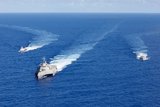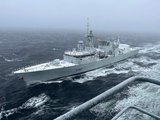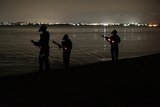Naval Warfare magazine: European forecast, amphibious ships, network defences and more
Read the latest edition of Naval Warfare for free in our app or on your desktop. Register below to be sent the download link and receive future editions direct to your inbox.
Comment
While the high-profile case of the USS Theodore Roosevelt has proved an object exercise in how not to do PR, many further lessons await the world's navies as the COVID-19 crisis unfolds.
Features include:

SHIELDED SYSTEMS
As the cyber domain comes to permeate all areas of military activity, naval vessels need to be designed from the keel up with robust network defences.

THE ART OF THE POSSIBLE
Transforming what was traditionally a single-purpose weapon, future generations of torpedoes could feature multiple detonation modes, function as a defensive capability or even serve a secondary role as ISR nodes.
Other features include:
IN HARM'S WAY
Landing helicopter dock and landing platform dock fleets are now widely regarded as too vulnerable for the amphibious assault role they were designed for. Shephard investigates their potential future task set and what kind of vessel could perform their originally intended mission.
SAVING SUBMARINES
Rescuing crews from a stricken submarine at depth is a challenging task requiring rapid deployment of highly specialised equipment and personnel. Shephard takes an in-depth look at NATO’s joint capability in this area.
OFFSHORE CONSTRUCTION
With the ability to patrol ever further out into territorial waters, and yet cheap enough to procure in quantity, the OPV is becoming the asset of choice for non-combat naval missions.
TROUBLE AHEAD
While many European navies are aiming to refresh their vessel inventories in the next decade, the inevitable impact of COVID-19 on budgets could curtail these efforts.
WESTERN APPROACHES
The Gulf of Guinea and its surrounding waters continue to suffer from elevated levels of piracy and robbery at sea. Shephard examines the causes of the problem and how it might be combated using lessons learned from other parts of the world.
LURED AWAY
Naval soft-kill technology is evolving to counter new and increasingly diverse threats as missiles increase in sophistication.

More from Naval Warfare
-
![Maritime defence in the Mediterranean faces challenges from vulnerable land power]()
Maritime defence in the Mediterranean faces challenges from vulnerable land power
As an indispensable energy crossroads, the Mediterranean is at serious risk from grey zone disruption. As navies increasingly employ AI data centres, what happens when cutting-edge defence technologies rely on the very infrastructure most susceptible to hybrid tactics?
-
![US Navy to conduct an experimentation campaign with emerging tech in 2026 and 2027]()
US Navy to conduct an experimentation campaign with emerging tech in 2026 and 2027
The Technology Operational Experimentation Events will inform future requirements as the US Navy looks for innovative solutions across three key operational domains.
-
![Future Canadian Continental Defence Corvette will provide “Halifax-equivalent capabilities”]()
Future Canadian Continental Defence Corvette will provide “Halifax-equivalent capabilities”
Although the CDC project is still in its early stages, the Canadian Department of National Defence already has some requirements for the future platforms.
-
![US Navy to acquire micro-uncrewed underwater vehicles for ISR and coastal data collection]()
US Navy to acquire micro-uncrewed underwater vehicles for ISR and coastal data collection
The Naval Supply Systems Command is seeking authorised resellers of JaiaBot uncrewed underwater vehicles and multivehicle pods. The platforms will support undergraduate education at the US Naval Academy.
-
![NATO tests use of “undetectable, jam-proof” laser communication in maritime scenarios]()
NATO tests use of “undetectable, jam-proof” laser communication in maritime scenarios
As part of its effort to better prepare its capabilities for operations in contested and congested scenarios, NATO evaluated a Lithuanian ship-to-ship terminal designed to not be susceptible to enemy interference.
























